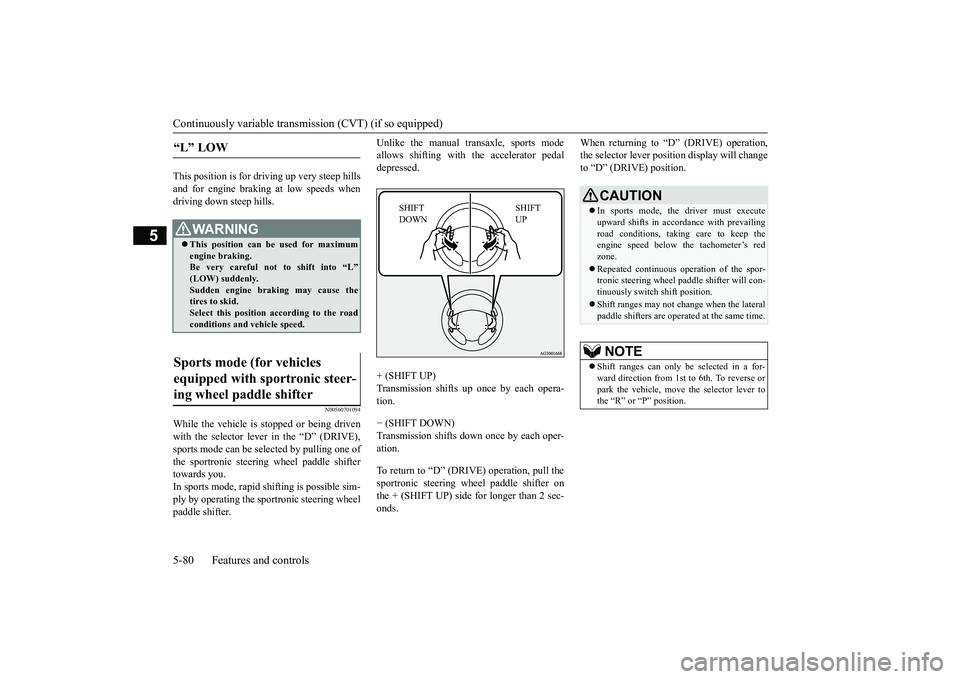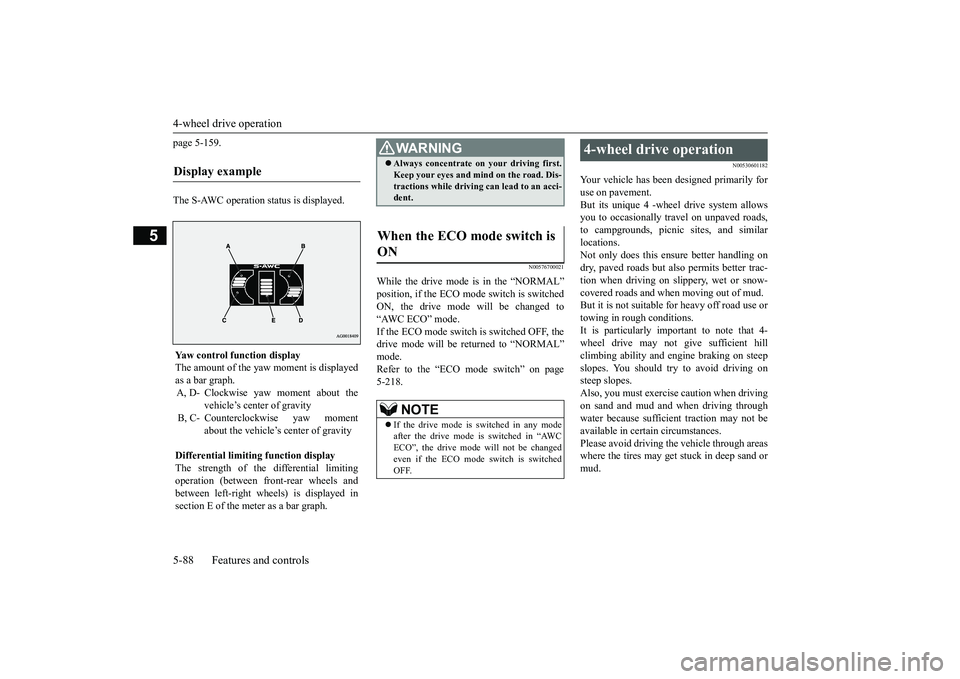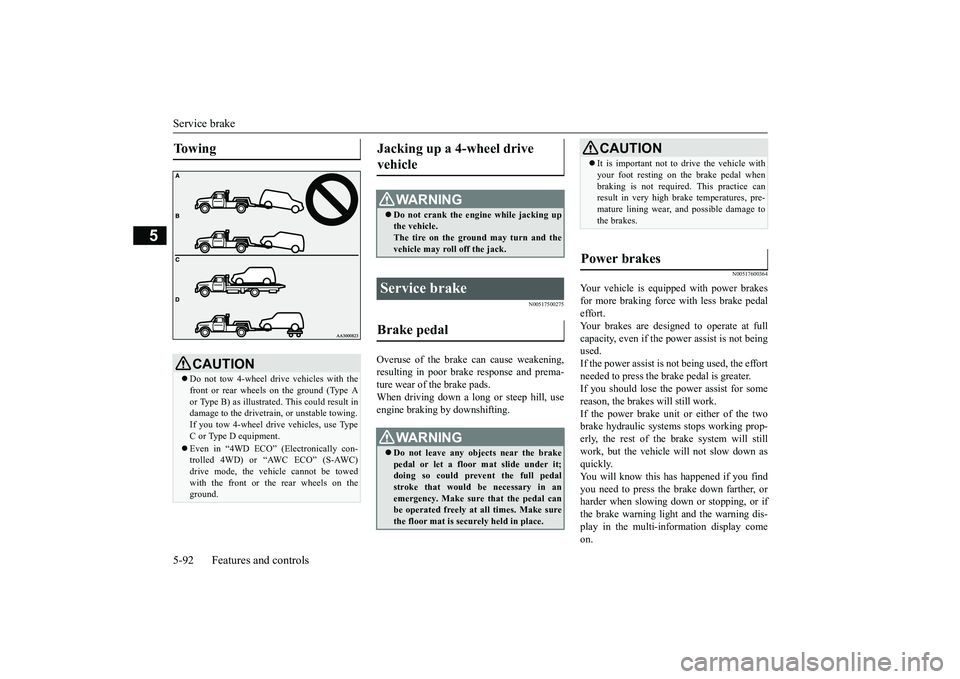2018 MITSUBISHI OUTLANDER III tow
[x] Cancel search: towPage 161 of 441

Continuously variable transmission (CVT) (if so equipped)5-80 Features and controls
5
This position is for driving up very steep hillsand for engine braking at low speeds whendriving down steep hills.
N00560701094
While the vehicle is stopped or being drivenwith the selector lever in the “D” (DRIVE),sports mode can be se
lected by pulling one of
the sportronic steering wheel paddle shiftertowards you.In sports mode, rapid
shifting is possible sim-
ply by operating the sportronic steering wheelpaddle shifter.
Unlike the manual transaxle, sports modeallows shifting with the accelerator pedaldepressed.+ (SHIFT UP)
up once by each opera-
tion.− (SHIFT DOWN)Transmission shifts down once by each oper-ation.To return to “D” (DRIVE) operation, pull thesportronic steering wheel paddle shifter onthe + (SHIFT UP) side for longer than 2 sec-onds.
When returning to “D” (DRIVE) operation,the selector lever posit
ion display will change
to “D” (DRIVE) position.
“L” LOW
WA R N I N GThis position can be used for maximumengine braking.Be very careful not to shift into “L”Sudden engine brak
ing may cause the
tires to skid.Select this position according to the roadconditions and vehicle speed.
Sports mode (for vehicles equipped with sportronic steer-ing wheel paddle shifter
SHIFT UP
SHIFT DOWN
CAUTIONIn sports mode, the driver must executeupward shifts in accordance with prevailingroad conditions, taking care to keep theengine speed below the tachometer’s redzone.Repeated continuous ope
ration of the spor-
tronic steering wheel pa
ddle shifter will con-
tinuously switch shift position.Shift ranges may not change when the lateralpaddle shifters are opera
ted at the same time.
NOTE
Shift ranges can only be
selected in a for-
ward direction from 1st to 6th. To reverse orpark the vehicle, move
the selector lever to
the “R” or “P” position.
BK0249100US.book 80 ページ 2017年5月10日 水曜日 午前8時49分
Page 169 of 441

4-wheel drive operation5-88 Features and controls
5
page 5-159.The S-AWC operation status is displayed.
N00576700021
While the drive mode is in the “NORMAL”ON, the drive mode
will be changed to
“AWC ECO” mode.If the ECO mode switch is switched OFF, thedrive mode will be returned to “NORMAL”Refer to the “ECO mode switch” on page5-218.
N00530601182
Your vehicle has been designed primarily foruse on pavement.But its unique 4 -wheel
drive system allows
you to occasionally travel on unpaved roads,to campgrounds, picnic
sites, and similar
locations.Not only does this ensu
re better handling on
dry, paved roads but also permits better trac-tion when driving on slippery, wet or snow-covered roads and when moving out of mud.But it is not suitable for heavy off road use ortowing in rough conditions.It is particularly im
portant to note that 4-
wheel drive may not gi
ve sufficient hill
climbing ability and e
ngine braking on steep
slopes. You should try to avoid driving onsteep slopes.Also, you must exercise caution when drivingon sand and mud and when driving throughwater because sufficient traction may not beavailable in certain circumstances.Please avoid driving the vehicle through areaswhere the tires may get stuck in deep sand ormud.
Display example
Yaw control function displayThe amount of the yaw moment is displayedas a bar graph.A, D- Clockwise yaw moment about the
vehicle’s center of gravity
B, C- Counterclockwise yaw moment
about the vehicle’s
center of gravity
Differential limiting
function display
The strength of the differential limitingoperation (between front-rear wheels andbetween left-right whee
ls) is displayed in
section E of the me
ter as a bar graph.
WA R N I N GAlways concentrate on your driving first.Keep your eyes and mi
nd on the road. Dis-
tractions while driving
can lead to an acci-
dent.
When the ECO mode switch is ON
NOTE
If the drive mode is switched in any modeafter the drive mode is switched in “AWCECO”, the drive mode will not be changedeven if the ECO mode switch is switchedOFF.
4-wheel drive operation
BK0249100US.book 88 ページ 2017年5月10日 水曜日 午前8時49分
Page 173 of 441

Service brake5-92 Features and controls
5
N00517500275
Overuse of the brake can cause weakening,resulting in poor brake response and prema-ture wear of the brake pads.When driving down a long or steep hill, useengine braking
by downshifting.
N00517600364
Your vehicle is equipped with power brakesfor more braking force with less brake pedaleffort.Your brakes are designed to operate at fullcapacity, even if the power assist is not beingused.If the power assist is not being used, the effortneeded to press the brake pedal is greater.If you should lose the power assist for somereason, the brakes will still work.If the power brake unit or either of the twobrake hydraulic systems stops working prop-erly, the rest of the brake system will stillwork, but the vehicle will not slow down asquickly.You will know this has happened if you findyou need to press the brake down farther, orharder when slowing down or stopping, or ifthe brake warning light and the warning dis-play in the multi-information display comeon.
To w i n g
CAUTIONDo not tow 4-wheel drive vehicles with thefront or rear wheels on the ground (Type Aor Type B) as illustrate
d. This could result in
damage to the drivetrain, or unstable towing.If you tow 4-wheel drive vehicles, use TypeC or Type D equipment.Even in “4WD ECO” (Electronically con-trolled 4WD) or “AWC ECO” (S-AWC)drive mode, the vehicle cannot be towedwith the front or the rear wheels on theground.
Jacking up a 4-wheel drive vehicle
WA R N I N GDo not crank the engine while jacking upthe vehicle.The tire on the ground may turn and thevehicle may roll off the jack.
Service brake Brake pedal
WA R N I N GDo not leave any objects near the brakepedal or let a floor mat slide under it;doing so could prevent the full pedalstroke that would be necessary in anemergency. Make sure that the pedal canbe operated freely at all times. Make surethe floor mat is securely held in place.
CAUTIONIt is important not to drive the vehicle withyour foot resting on the brake pedal whenbraking is not required.
This practice can
result in very high brake temperatures, pre-mature lining wear, a
nd possible damage to
the brakes.
Power brakes
BK0249100US.book 92 ページ 2017年5月10日 水曜日 午前8時49分
Page 183 of 441

Active stability control (ASC)
5
N00546601129
If an abnormal condition occurs in the sys-tem, the following disp
lay/indicator will turn
on.Warning display
N00546301070
CAUTIONWhen display/indicator blinks, ASC isoperating, which means that the road is slip-pery or that your vehi
cle’s wheels are begin-
ning to slip. If this happens, drive slower.If the temperature in the braking system con-tinues to increase due
to continuous brake
control on a slippery
road surface, the
indicator will blink.To prevent the brake system from overheat-ing, the brake control
of the traction control
function will be tem
porarily suspended.
The engine control of the traction controlfunction and normal brake operation will notbe affected.Park your vehicle in a safe place. When thetemperature in the braking system has comedown, the indicator will be turned off andthe traction control func
tion will start operat-
ing again.NOTE
The indicator may come on when youstart the engine. This means that the batteryvoltage momentarily dropped when theengine was started. It
does not indicate a
malfunction, provided th
at the display goes
out immediately.
When a spare tire has been put on your vehi-cle, the gripping ability of the tire will belower, making it more likely that the dis-play/indicator will blink.
ASC warning display
-
ASC indicator
-
ASC OFF indicatorNOTE
CAUTIONThe system may be malfunctioning.Park your vehicle in a
safe place and stop the
engine. Restart the engi
ne and check whether
the display/indicator goe
s out. If they go out,
there is no abnormal condition. If they do notgo out or if they turn on frequently, it is notnecessary to stop the
vehicle immediately,
but you should have your vehicle inspectedby an authorized Mitsubishi Motors dealer ora repair facility of
your choice as soon as
possible.
To w i n g
CAUTIONIf the 2WD vehicle is to
wed with the ignition
switch in the “ON” pos
ition or the operation
mode in ON and only the front wheels oronly the rear wheels raised off the ground,the ASC may operate, resulting in an acci-dent. When towing the 2WD vehicle with thefront wheels raised, keep the ignition switchin the “OFF”, “LOCK” or “ACC” position orthe operation mode in ACC or OFF. Whentowing the vehicle with the rear wheelsraised, keep the ignition switch in the “ACC”Refer to “Towing” on page 8-14.
BK0249100US.book 102 ページ 2017年5月10日 水曜日 午前8時49分
Page 193 of 441

Adaptive Cruise Control System (ACC) (if so equipped)5-112 Features and controls
5
N00576900036
While the ACC is activated, if your vehicle isapproaching too closely to the vehicle infront, the ACC gives a warning by sounding abuzzer and displaying a message. Apply thebrakes to maintain the appropriate distance tothe vehicle in front.When the vehicle in
front has changed its
course or lane, if a stationary vehicleappears in front you
r vehicle, the ACC
will not decelerate your vehicle.
Approach alarm
WA R N I N GWhen the ACC is not being used, turn offthe system to avoid
unexpected ACC acti-
vation.Never operate the AC
C from outside the
vehicle.WA R N I N G
The ACC will not decelerate your vehicleand/or give the approach alarm in the fol-lowing cases.• When an object other than a vehicle,such as a pedestri
an, is in front.
• When a malfunction is detected in thesystem.
The ACC will not decelerate your vehiclein the following cases, but will give theapproach alarm.• When the front vehicle is stationary ormoving at an extr
emely slow speed.
• When your brake system has a problem,such as overheating.
The ACC may not be able to maintain theset speed or the dist
ance to a vehicle in
front and may not alert the driver, if thesystem cannot detect the front vehicleproperly. Typical situations include: • When a vehicle cuts
into your path at a
close distance.• When a vehicle in front is not completelyin your path.• When a vehicle in front is towing atrailer.• When a motorcycle or a bicycle is infront.• When a vehicle in fr
ont is a truck loaded
with freight that protrudes rearwardfrom the cargo bed.WA R N I N G
• When the height of a vehicle in front isextremely low or the road clearance ofthe vehicle is extremely high.• When driving on a r
oad with alternating
up and down surfaces.• When driving on a curve.• When driving on a bumpy or rough road.• When driving in a tunnel.• When driving in construction zones.• When the rear of your vehicle is weigheddown with the weight of passengers andluggage• For up to two minutes after starting driv-ing.• When driving in curved sections of roadincluding their entrance/outlet or run-ning beside a closed lane in a traffic workor similar zone.• When the surface of th
e sensor is covered
with dirt, snow, ice, etc.• When a front vehicle or an oncomingvehicle is splashing wa
ter, snow or dirt.
WA R N I N G
BK0249100US.book 112 ページ 2017年5月10日 水曜日 午前8時49分
Page 194 of 441

Adaptive Cruise Control System (ACC) (if so equipped)
Features and controls 5-113
5
N00581500027
There are two ways to increase the set speed.The set speed will increase by 1 mph (1km/h) every time you push up the “RES +”switch while the ACC is activated. If youhold the switch pushed up, the set speedincreases in 5 mph (5 km/h) increments.
When the accelerator
pedal is depressed
while driving with the ACC control working,you can accelerate the vehicle beyond thepresently set speed.When the vehicle speed reaches your desiredspeed, push down and release the “SET -”
a winding road.
Never use the ACC in the following situa-tions:• In heavy traffic.• On winding roads.• On slippery roads, such as icy, snow-cov-ered or dirt roads.• In adverse weather conditions, such asrain, snow or sand storms, etc.• On steep downslopes.• When the inclination of a road fre-quently changes.• When the approach alarm frequentlysounds.• When your vehicle is towed or is towinganother vehicle.• When your vehicle is on a chassis dyna-mometer or free rollers.• When tire inflation pressures are notadequate.• When the temporary sp
are tire is being
used.• When the radar sensor and/or its sur-rounding area are damaged or deformed.WA R N I N G
CAUTIONTo maintain proper performance of the ACC:• Always clean the surface of the radar sen-sor.• Avoid impacting the radar sensor or its sur-rounding area.• Do not put a sticker on the radar sensor orits surrounding area.• Do not paint the radar sensor.• Do not install a grill guard.• Do not modify the radar sensor or its sur-rounding area.• Always use tires of the same size, sametype, and same brand, and which have nosignificant wear differences.• Do not modify the vehicle’s suspension.
To increase the set speed
By using the “RES +” switch:
NOTE
There is some time
lag until the vehicle
begins accelerating to
the new set speed after
the set speed has been changed.The set speed can be changed even whileyour vehicle is followi
ng a vehicle in front
using the ACC. In this case, however,although the set speed itself is increased,your vehicle will
not accelerate.
When the switch is held, a buzzer will soundevery time the set speed changes
By using the accelerator pedal:
BK0249100US.book 113 ページ 2017年5月10日 水曜日 午前8時49分
Page 203 of 441

Forward Collision Mitigation System (FCM) (if so equipped)5-122 Features and controls
5
N00577800090
This switch is used to turn on or off the FCM,and also to select the distance which will trig-ger the forward colli
sion warning function.
• When a vehicle in the next lane becomespositioned directly in
front of your vehi-
cle due to winding road conditions.• When passing through an area thatobjects may contact th
e vehicle, such as
thick grass, tree br
anches, or a banner.
• When there are patterns on the road thatmay be mistaken for
a vehicle or a pedes-
trian.• When a vehicle cuts into your path in thedetecting range of the sensor.• When an oncoming vehicle is positionedstraight ahead of your vehicle on acurved road.• When the FCM detects a long object car-ried on your vehicle,
such as skies or a
roof carrier.• When driving through fog, steam, smokeor dust.
The FCM should be tuned off if any of fol-lowing situations occur:• When using an automatic car wash.• When the tires are not properly inflated. • When the emergency spare tire is used.WA R N I N G
• When your vehicle is
towed or
your vehi-
cle tows another vehicle.• When your vehicle is
carried on a truck.
• When your vehicle is on a chassis dyna-mometer or free rollers.• If the windshield on or surrounding thesensor is cracked or scratched.NOTE
When depressing the brake pedal while auto-matic braking is applie
d, the brake pedal will
feel firm. This is normal. Depress the brakepedal harder to apply
greater braking force.
During the automatic
braking, operating
sounds may be heard.
This is normal.
WA R N I N G
FCM ON/OFF switch
BK0249100US.book 122 ページ 2017年5月10日 水曜日 午前8時49分
Page 210 of 441

Blind Spot Warning (BSW) (with Lane Change Assist) (if so equipped)
Features and controls 5-129
5
When the BSW indicator light in the instru-ment cluster is on, if a vehicle is approachingyour vehicle in the dete
ction area, the Blind
Spot Warning light in the outside rearviewmirror illuminates.If the turn signal lever is operated to the sidewhere the Blind Spot Warning light is illumi-nated, the Blind Spot Warning light will blinkand the system will beep three times to alertthe driver.
N00592400039
If a problem occurs with the system, a visualwarning specific to the type of the problem isgiven together with an audible alarm.The warnings are combined with the RearCross Traffic Alert (RCTA) system.
NOTE
When the operation mode is set to OFF, theselected condition just
before setting to OFF
is retained.The BSW operates when all of the followingconditions are met.• The operation mode is put in ON.• The selector lever is
in positions other than
“P” (PARK) and “R” (REVERSE).• The speed of your vehi
cle is approximately
6 mph (10km/h) or higher.
When the sensor detects an approaching vehicle
NOTE
The Blind Spot Warni
ng light in the outside
rearview mirror may come
on or blink in the
following conditions.• When driving very near the guardrail or theconcrete wall.
• When driving on the entrance and outlet ofthe tunnel or very near
the wall or near the
evacuation area inside the tunnel.• When turning a intersection in a town area.• Under adverse
weather condi
tions (rain,
snow, sand storms etc.).• When the your vehicle
drives with blowing
up the water, snow or sand etc. on the road.• When driving near a curb, pot hole andtramline.
Set the BSW to OFF when towing.The Blind Spot Warning light in the outsiderearview mirror may
not look due to strong
direct sunlight or th
e glare from the head-
lamps of vehicles
behind you during night
driving.
System problem warning
NOTE
BK0249100US.book 129 ページ 2017年5月10日 水曜日 午前8時49分